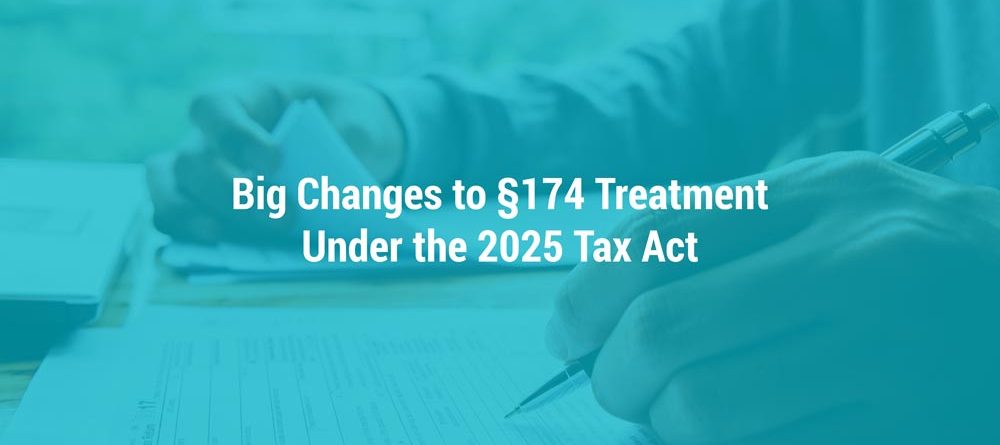Big Changes to §174 Treatment Under the 2025 Tax Act
As part of the 2025 tax law changes (notably via the One Big Beautiful Bill Act or OBBBA), the treatment of research & experimental (R&E) expenditures, often referred to under Internal Revenue Code Section 174, has undergone major shifts. These changes affect how domestic and foreign R&E are expensed or amortized, how “catch‑up” deductions work, and offer special elections for small business taxpayers. For firms dealing with R&D, software development, or innovation, understanding these adjustments is crucial to optimizing tax outcomes and cash flow.
In this post, we will break down:
- What §174 (now §§174 / 174A) is and what the 2025 changes do
- What clients (both large and small) should be doing now to take advantage
- Summary of procedural guidance under Revenue Procedure 2025‑28 for small taxpayers
What is §174 / §174A & What Changed?
Here are the high‑level bullet points describing new rules, and what OBBBA introduced:
Aspect |
New / Changed Under OBBBA (One Big Beautiful Bill Act) |
Domestic R&E (paid or incurred) |
Under new §174A, taxpayers have options: either 100% expensing of domestic R&E paid/incurred in tax years beginning after December 31, 2024, OR amortization over not less than 60 months. Foreign R&E is still subject to 15‑year amortization. |
Timing / Period for Unamortized Costs |
New law lets taxpayers recover remaining unamortized domestic R&E from those years (2022‑2024) by accelerating the deduction: either fully in 2025 or ratably over 2025 and 2026. |
Elections & Method of Accounting |
OBBBA (and Rev. Proc. 2025‑28) introduces more flexibility, especially for small businesses: retroactive elections, superseding returns, statements in place of some Form 3115s, etc. Also changes in §280C(c) rules (how the research credit interacts with deductions or expensed/amortized R&E) for those electing under §174A. |
Effective Dates |
OBBBA changes for domestic R&E begin for tax years beginning after Dec. 31, 2024. Retroactive applications permitted for small businesses to years after Dec. 31, 2021 up to the end of 2024. Deadlines for elections / amendments (e.g., small business) extend into mid‑2026. |
What Clients Should Do Now: Planning & Actions
Here are what forward‑thinking businesses should be doing to make the most of the new §174 / §174A rules:
- Review Your R&E / Software‑Development Costs
Identify your domestic vs. foreign research/experimental expenditures, dates incurred, and how they were treated for 2022‑2024. Quantify the unamortized balance as of Dec. 31, 2024. - Determine If You Qualify as a “Small Business Taxpayer”
Under the gross receipts test: if your average annual gross receipts are $31 million or less (as per §448(c)) for the first taxable year beginning after Dec. 31, 2024, you may be eligible for more favorable elections. - Decide whether to Expense under §174A(a) or Amortize under §174A(c)
For domestic R&E paid/incurred after Dec. 31, 2024, you now have a choice: full expensing vs. amortization over ≥ 60 months. - Plan for Catch‑Up / Deduction of Unamortized Costs from 2022‑2024
If you incurred domestic R&E in 2022‑2024 (capitalized under the old rule), you can recover the unamortized amount either fully in 2025 or over 2025‑2026. - Make Elections / Amend Returns / Supersede Returns Where Needed
- Coordinate with §280C / Research Tax Credit
Be aware that the deduction (or the amount charged to capital account) for R&E under §174A is reduced by the credit under §41, unless you make the reduced credit election under §280C(c)(2). Small businesses have new guidance on making late or revoking §280C(c)(2) elections if advantageous.
Technical Summary: Procedural Guidance under Rev. Proc. 2025‑28 for Small Taxpayers
Here is a breakdown of what Rev. Proc. 2025‑28 provides, especially for “small business taxpayers,” how elections, method changes, 280C elections, and unamortized cost recovery work.
For businesses with significant R&D, software development, or experimental expenditures, there are real opportunities now to accelerate deductions, clean up unamortized costs, and improve cash flow.
Expensing Section 174 Costs:
- Small business taxpayers (must meet the § 448(c) gross receipts test) may elect to retroactively expense or amortize domestic Section 174 costs for tax years 2022–2024.
- The election is made by attaching a detailed statement to each affected year’s original or amended return (or AAR), specifying eligibility, the method chosen, and the amortization period if applicable.
- The deadline for making this election is the earlier of July 6, 2026, or the expiration of the statute of limitations for the year.
- If a qualifying small business has not filed its 2024 original tax return yet, there is an ability to include a method change on the 2024 originally filed tax return (statement in lieu of a Form 3115), with a favorable catch-up adjustment, and not have to amend 2022-2023 returns.
Electing Section 280C:
- Under the new rules, the deduction or amount charged for domestic R&E under §174A is reduced by the research credit under §41 unless the taxpayer makes an election under §280C(c)(2), which allows using a reduced credit instead (so you don’t have both full deduction and full credit).
- Small taxpayers making the Section 174A election may also make or revoke a late Section 280C(c)(2) election for the research credit for eligible prior years.
- The late election is made by filing an amended return or AAR with an amended Form 6765 and required statements.
- The same deadline applies: the earlier of July 6, 2026, or the expiration of the statute of limitations for the year. Once made, the election is irrevocable for that year.
Conclusion
The 2025 changes to §174 via OBBBA represent a big shift back toward more favorable treatment of domestic R&E costs than the strict amortization required under the early years of the TCJA‑amended §174. For businesses with significant R&D, software development, or experimental expenditures, there are real opportunities now to accelerate deductions, clean up unamortized costs, and improve cash flow. But success hinges on timely elections, clear documentation, and coordination with research credits. If you have not yet reviewed your R&E cost treatment, now is the time.
Hungerford is Here to Help
Navigating these new tax changes can be complex—but the potential savings are substantial. Reach out to Hungerford today to learn exactly how the 2025 changes will affect your situation and to develop a personalized tax strategy that maximizes your benefits.
Disclaimer: This blog post is for informational purposes only and does not substitute for personalized advice. Please consult your tax professional for guidance tailored to your situation.











